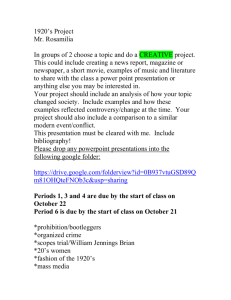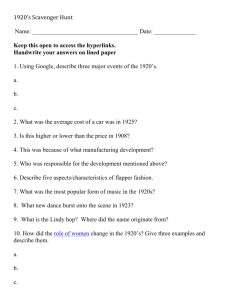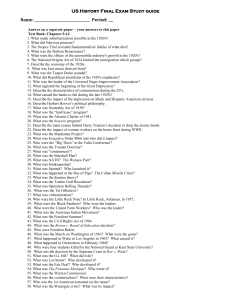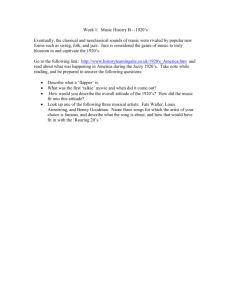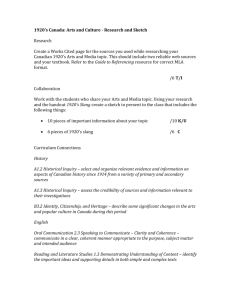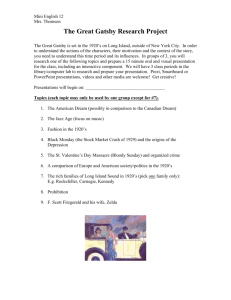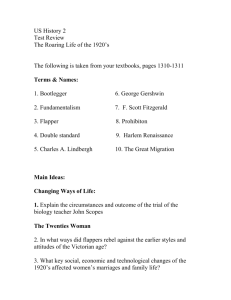1920s Overview
advertisement
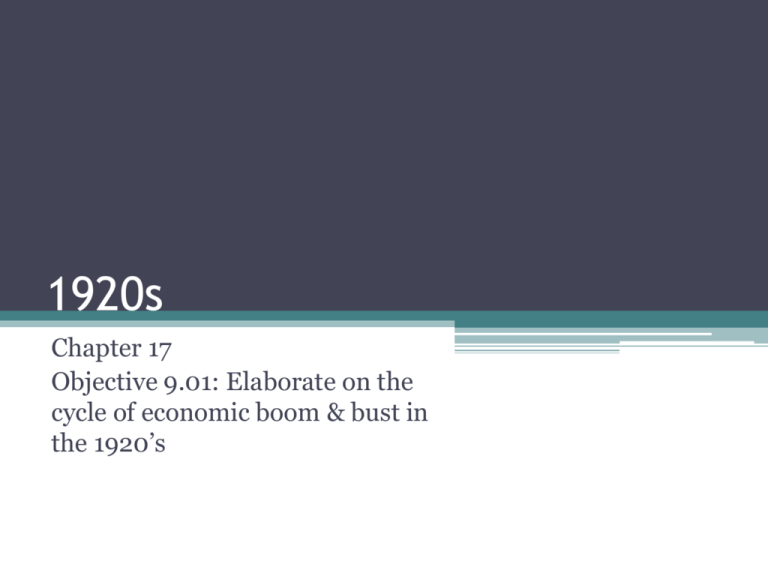
1920s Chapter 17 Objective 9.01: Elaborate on the cycle of economic boom & bust in the 1920’s Harding Scandals • * “The Ohio Gang” ▫ Harding’s friends he appointed to office ▫ Were embroiled in scandals • Named boyhood friend Chairman of the Federal Reserve Bank • Some of Harding's friends used positions in government to make money • Charles Forbes -head of Veterans Administration sold scarce medical supplies & kept money for himself. • *Teapot Dome Scandal (1922) Sec. of Interior (Albert Fall) leased US lands w/ navy oil reserves to private companies “Silent Cal” Takes Over • 1923- President Harding died while visiting San Francisco (complications from pneumonia & thrombosis) • Vice President Calvin Coolidge- was sworn in by his father (justice of the peace in Vermont) • Calvin Coolidge- knew 5 languages but spoke very little – he could be “silent in five languages”= “Silent Cal” • Fired Harding's crooked friends in government Coolidge kept Harding’s good appointees: • Charles Evan Hughes- Sec. of State • Herbert Hoover- Sec. of Commerce • Andrew Mellon- Sec. of Treasury **Coolidge avoided crisis & adopted policies (laissez-faire) that made the US prosperous Election of 1924 1. Republicans- nominated Calvin Coolidge- “Keep Cool with Coolidge” 2. Democrats- party was split between “wets”, “drys”, urbanites, farmers= nominated John Davis (Wall Street man). 3. New Progressive Party- nominated Robert La Follette (Progressive Gov. of Wisc). • Called for government ownership of RR • Help for farmers ** Calvin Coolidge won easily!! “The Chief Business of the American People is Business”-Coolidge **Sec. of Treasury –Andrew Mellon (business tycoon)- helped lead US to prosperity in the 1920’s • Worked for all presidents in the 1920’s Policies: 1. Balance the nation’s budget- est. a Bureau of Budget 2. Reduce government debt 3. Cut taxes for US businesses (*supply-side economics) US Economy 1920’s -Overview • • • 1. 2. 3. 4. 1921- brief post WWI recession (inflation, strikes, job shortages) 1922-1928- period of prosperity 1929- Stock market Crash- start of the Depression Unemployment remained low Standard of living rose (lowered taxes) Indoor plumbing & heating became more common 40% of urban & rural areas had incomes in poverty range The Washington Naval Conference (1921) • Problem: Post-WWI- major powers involved in massive weapons buildup. • US invited major powers to Washington (led by Sec. of State Charles Evan Hughes) • US promised a 10 year halt on construction of new warships • Created a list of old warships to be destroyed. 1. Five Power Limitation Treaty- Britain, France, Japan, Italy, & US agreed to Hughes idea. • Failures: did not limit land forces, required Japan to keep smaller navy than US or Britain. Foreign Policies • *The Dawes Plan (1924) • US allies could not pay war debts due to high US tariffs – Germany could not pay war debts ▫ American banks would loan money to Germany to make its reparations payments ▫ France & Britain would require less ▫ Caused France & Britain to go further into debt • The Kellogg Briand Pact (1928) ▫ Treaty outlawing war ▫ US & 14 nations signed ▫ Problem: Allowed defensive wars Sec.2- A Growing Economy • Assembly line production allowed new industries to grow 1. Henry Ford: introduced the auto in late 1800’s. • 1908- Introduced the Model T sold for $850 • Used assembly line methods • 1913- installed 1st moving assembly line • 1914 Model T sold for $490; 1924=$295 • GM, Chrysler emerged as competitors • Auto industry= growth in rubber, glass, nickel, lead, petroleum businesses Ford & His Workers • 1914- Ford increased worker wages to $5 a day • Reduced workday to 8 hour shifts ** increased worker loyalty & undercut unions “Sociological Department”- set requirements workers had to meet= renting space in one’s home for nonfamily members forbidden. Social Impact of the Car 1. eased isolation of rural life 2. Enabled people to live farther from work 3. Allowed younger generation some freedom from parents Birth of the Airline Industry • 1903- *Orville & Wilbur Wright- made 1st crewed, powered flight in history at Kitty Hawk, NC. • 1907- Glenn Curtiss- invented ailerons (surfaces attached to wings that can tilt to steer planes)= built aircraft for US & Allies during WWI. • **Post WWI-most people thought airplanes dangerous novelties • 1918- US introduced 1st airmail service- hired private airplane owners • 1925- Kelly Act- US government contracts with private airplane owners to deliver mail • 1926- Air Commerce Act- federal money to build airports • **1927- Charles Lindberg- 1st transatlantic solo flight (landed in Paris)= proved air travel was safe • **1928- 48 airlines served 355 US cities. The Birth of Radio • 1913- Edwin Armstrong- invented a special circuit that made transmission of voice & music practical. • *Nov. 1920- 1st public commercial radio broadcast= Harding's Election victory 1920 (KDKA) • 1926 NBC; 1928 CBS • 1927—700 stations dotted the country. • 1928- 1st presidential election in which both parties bought ad time on radio The Growth of Consumer Society 1. Easy Credit • Individuals began to borrow more in the 1920’s • Before the 1920’s-- Most Americans considered debt shameful • Americans bought 75% of radios & 60% of cars on credit in the 1920’s • Americans also bought stock on credit! 2. Mass Advertising • Manufacturers spent more money on ads in the 1920’s • Used ideas of convenience, leisure & style to draw customers to products. 3. Managerial Revolution: companies created departments & placed managers over each= new middle class= more consumer buying power. 4. Welfare Capitalism: introduced by businesses to undercut unions; offered employees benefits, retirement, stocks etc.= more disposable income for industrial workers. The Decline of Unions • 1920’s unions lost influence & members 1. Open shops- employers promoted idea of a workplace where union membership was not required. 2. Workers were more prosperous in the 1920’s Uneven Prosperity • Not all Americans enjoyed economic prosperity • African-Americans & women left war jobs when soldiers returned • New immigrants found good paying jobs hard to find • *Farmers did not have good economic times • Problems for farmers= borrowed during WWI to make profit= higher debts • Farmers earned less than 1/3 income of other workers. • Post WWI- foreign competition & high tariffs = less demand & lower prices for crops= debt. Helping Farmers • 1924-1928 –some members of Congress introduced bills to help farmers • McNary-Haugen Bill- government would buy up surplus crops & sell them at a loss over seas. • Congress passed bill twice-Coolidge vetoed it twice. ** Farmers mired in recession in 1920’s A Clash of Values (17.3) NC Objective 9.02 –Analyze the extent of prosperity for different segments of society during the 1920’s. NC Objective 9.04: Describe challenges to traditional practices in religion, race, and gender. Nativism & Racism increased during the 1920’s & led to changes in immigration policy. Nativism Resurges Causes: 1. Post-WWI recession (1920-1921) 2. Influx of “new immigrants”- SE Europeans 3. Cultural Tensions Immigration- dropped during WWI • Post WWI –back to prewar norms • Increase in strikes, bombings • Immigrants competed with former US soldiers for jobs *The Sacco-Vanzetti Case (1921)- two Italian immigrants (anarchists) found guilty of murder & executed in 1927. ** example of nativism of the time period The Return of the KKK • Before 1920’s- Klan attracted few members • 1915- William J. Simmons – formed the “New Klan”- to preserve America’s white , Protestant civilization. • *New Klan targeted – Catholics, Jews, immigrants, & other “un-American” groups. • *1920’s- Klan attracted many new members in the south & north (hired public relations experts to promote membership) • 1924= 4 million members = demanded immigration limits • *LATE 1920’s- Klan membership declined due to scandals within the Klan Controlling Immigration • *1921 Emergency Quota Act- limited admission to the US based on 3% of an ethnic group already living in the country; ethnic identity & national origin determined admission. • Exempted people in the western hemisphere= Hispanics =700,000 migrated to US. • 1924- *National Origins Act- made immigration restrictions permanent; set new ethnic quota of 2% of each ethnic group based on 1890 census. A CLASH OF Values- New Morality • • 1. 2. 3. 4. 5. • • Supporters of “new morality” in the 1920’s clashed with people who supported traditional values. “new morality” – glorified youth & personal freedom; emphasized the status of women. 1920 women gained the right to vote= Women challenged ideas about sexuality & relationships. Automobile allowed young people to escape Working women gained financial independence & became consumers of goods. Fashion changed- dresses shortened, hair was “bobbed”= the “flapper” was the symbol of the “new morality” of the 1920s. Women made gains in science, medicines, literature Margaret Sanger- American Birth Control League (1921)= Planned Parenthood (1941) Middle Class couples practiced birth control in the 1920’s The Fashion of the 1920’s – New Morality Fundamentalism • • Many Americans did not embrace the ‘new morality” Fundamentalists believed that new morality was leading to the moral decline of America Beliefs of Fundamentalists 1. The Bible is literally true & without error 2. Believe in creationism– not evolution • Billy Sunday- preacher who used showmanship & rapid-fire sermons. • Aimee Semple McPherson – LA preacher whose sermons used costumes & sets to sway audiences. ** Scopes Trial or Scopes “Monkey” Trial (1925)- teacher challenged Tenn. Law which outlawed teaching anything that denied creationism. • 8 days of trial; Scopes found guilty & fined $100 (later overturned) • Trial broadcast over the radio- hurt Fundamentalist cause 1920’s Fundamentalist Preachers Prohibition • *18th Amendment (1920)- outlawed alcohol in the US. • *Volstead Act – made US Treasury Dept. responsible for enforcing prohibition. • Dramatic increase in federal government power over states. • 1920’s Treasury made 540,000 arrests- no effect. • “Speakeasies”- bars where illegal alcohol could be purchased. • “Bootlegging”- rural areas • Organized crime flourished (Al Capone –Chicago) • 21st Amendment (1933) repealed prohibition. Art & Literature 1920’s • Centers for art & literature= Greenwich Village (Manhattan) & the South Side (Chicago). 1. Modern American Art: various styles attempted to express individual & modern experience. • *Edward Hopper- revived realism; paintings convey disenchantment & isolation (Automat) • Georgia O’Keeffe- landscapes & flowers 2. Poets & Writers- varied greatly in styles. • Carl Sandburg- used common speech to glorify the Mid-west. • Willa Cather- wrote about life on Great Plains. Automat – by Edward Hopper *The “Lost Generation” writers • 1. 2. 3. 4. 5. 6. *“Lost Generation” writers of the 1920’s were disillusioned with materialism & negative aspects of modern life. T.S. Elliot- The Hollow Men *Ernest Hemingway- wrote about disillusionment with war- For Whom the Bell Tolls & A Farewell to Arms. *Sinclair Lewis- wrote Babbitt & Main Street (absurdities of modern small town life) *F. Scott Fitzgerald- wrote about colorful characters chasing futile dreams- The Great Gatsby Edith Wharton- The Age of Innocence- criticized high class society- won Pulitzer Prize (1920) Eugene O’Neil- tragic playwright Popular Culture • Economic Prosperity of 1920’s gave Americans more money & leisure time. 1. Motion Pictures- until 1927 movies had no sound except for piano players in movie theaters. • The Jazz Singer (1927) 1st movie with sound. 2. Radio- most Americans were entertained by radio in the 1920’s. • KDKA broadcast of Harding’s election victory 1920 (1st public radio broadcast) • 1922- 400 radio stations existed • *Amos n’ Andy- famous radio show; featured two white men who were playing black characters. 3. Mass Media- radio, movies, literature helped breakdown cultural barriers= sense of shared experience. Sports 1. Baseball- *Babe Ruth (715 homeruns); “Sultan of Swat” 2. Boxing- Jack Dempsey-heavy weight champ 1919-1926. 3. Football- Red Grange- the “galloping ghost”; Univ. of Ill. 4. Golf- Bobby Jones won 1st US Open (1926) 5. Tennis- Bill Tilden & Helen Wills Sec.5- *The HARLEM RENAISSANCE • WWI & 1920’S African-Americans moved from the South to settle in Northern cities= The Great Migration • In the North, they faced job discrimination & economic inequality • The North still offered better economic choices. • African-American populations swelled in cities like: NYC- Harlem. • *Harlem Renaissance- the flowering of black artistic development that grew in the northern cities. *Key Harlem Renaissance Writers/ Artists • Claude McKay- 1st prominent black writer of Harlem Renaissance; showed bitter contempt for racism. • **Langston Hughes- most prominent Harlem Renaissance writer/poet; wrote A Negro Speaks of Rivers & A Dream Deferred. • Zora Neal Hurston- Their Eyes Were Watching God; stories about rural life of African-Americans set in Florida; featured female characters. Music- Jazz *Jazz- a style of music influenced by Dixieland blues & ragtime; 1922 introduced to Chicago by New Orleans native Louis Armstrong. • Duke Ellington- 1923 formed a band & played in speakeasies in NYC.- formed his own sound & blend of jazz. • *The Cotton Club- most famous nightclub in Harlem; most jazz artists played there Blacks in Politics in the 1920’s • 1919- 1,300 African-American WWI vets marched on Washington= new aspirations of the 1920’s. • Most African-Americans voted Republican & became a major voting power in the north • Oscar Depriest- 1st African-American representative for Congress from a Northern state (1928). • NAACP-lobbied against lynching & blocked a racist NC judge to US Supreme Court Black Nationalism • Black pride– led to many people calling for separation from white society. • ** Marcus Garvey: (Jamaican Immigrant)- introduced “Negro Nationalism”- glorified black culture & traditions. • Founded Universal Negro Improvement Association (UNIA)pushed for black economic & political power using education; also advocated separation from white society. • 1920’s- Garvey proposed leading African-Americans back to Africa • Ideas rejected by Black Middle class • 1923- Garvey convicted of mail fraud= sent to prison • 1927- Garvey was released from prison (Pres. Coolidge) & deported back to Jamaica • Outcome of black national movement1. Increased black pride & unity 2. Laid foundations of the Black power movement of the 1960’s

